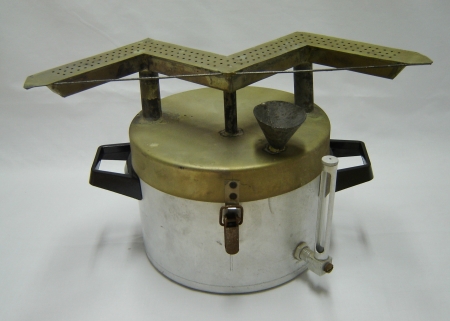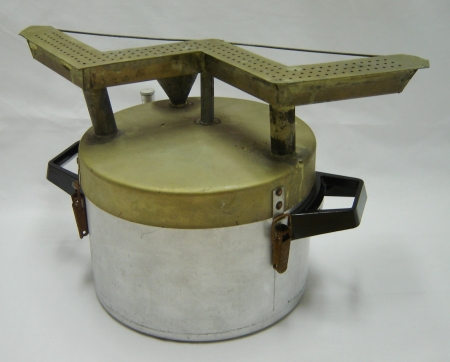
Credit: Museum in der Runde Ecke
Like other devices constructed in the 1970’s and ‘80s by Department M and the Stasi OTS, this “Aufdampftopf” (“steam pot”) was fashioned using a basic household appliance as a starting point. Starting with a “cooking pot,” as it’s called in the Museum in der Runde Ecke index, the vessel was altered with a tight lid so it could be used to heat water (added via the attached funnel) and generate, collect, and disperse steam for opening letters.
The “W” shape of the vapor dispersing grid on top corresponds to the adhesive edges of, not one, but two envelopes placed end to end on the mesh. Presumably an administrator or other coworker made a human mechanical observation in the spirit of efficiency, suggesting that if the grid was expanded then workers could open two envelopes at once.
Like the Kleindampfentwickler with vapor dispersion grid on its top, the Dampfentwickler made from a steam pot also uses copper tubes and plating in its construction. Likewise, the steam pot additions exhibit a DIY aesthetic that contrasts with the mass produced original object. The copper, again chosen for its malleability and capacity to withstand water, shows signs of use in its darkening patina. It gives the steam pot the appearance of a prop for a dystopian science fiction film, or at least a reference to a real thing, inspiring one to think of a steampunk look popular among cosplayers.

Credit: Museum in der Runde Ecke
The Stasi’s practice of taking bits and pieces from whatever was available might have been based on scarcity given the economic constraints in communist GDR, but their hacked outcomes have a specific “remix aesthetic,” to borrow the term Eduardo Navas uses in his book Remix Theory: The Aesthetics of Sampling. Specifically, the Stasi’s reuse and appropriation of objects and materials towards utilitarian ends expresses itself in the same way the “sampling” of a DJ or musician might. Given the motivations for, uses of, and choices in construction of this device—to secretly open personal communications between individuals and examine their contents (which of course happens on the part of governments and corporations nowadays)—an art historian or anthropologist might term this a classic example of “early hacker”.
- Steam generator for opening letters (Inventory no. 00042). Objekt- und Fotodatenbank Online im Museum in der Runden Ecke. Accessed June 10, 2017.